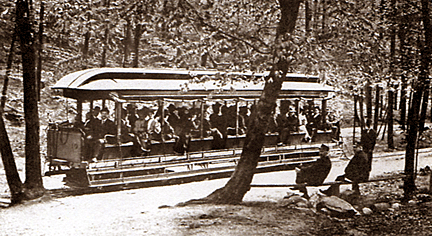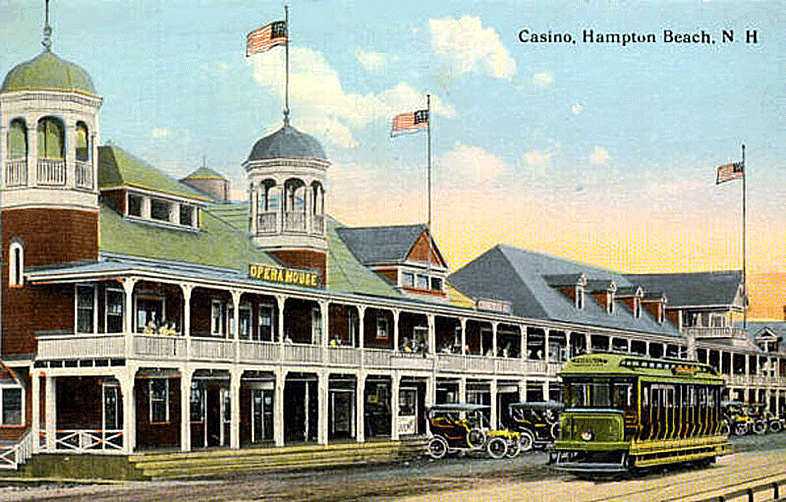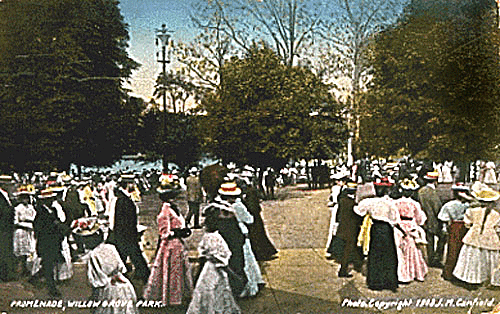|
 Electric traction companies built their
lines to handle the crowds of workers going to and from their jobs. But for
most of the rest of the time, the cars ran almost empty. Electric traction companies built their
lines to handle the crowds of workers going to and from their jobs. But for
most of the rest of the time, the cars ran almost empty.
Streetcar companies began to dream up ways to get people
to ride their cars on weekends and holidays. If a car line could easily be
extended to a beach or a natural scenic attraction, a line would be laid out
to the countryside and a picnic grove or amusement park built there,
specifically to generate off-hours traffic. So the companies actively
advertised the pleasures of joy riding. People took trolley rides just for
fun.
Trolleys were a pleasant way to explore unknown parts of a
city. They were leisurely and cheap and afforded a fine car-window view of
the neighborhoods through which they passed. And when there was a specific
destination–the circus, zoo, fair grounds, or lake--just going there by
trolley was part of the fun, a time of heightened anticipation and
excitement.
For many a youngster, a streetcar ride was the prelude to
almost every kind of outing. A few blocks away from the end of the car
tracks there would be real country, fine for picnics, hikes, and the
imaginative stalking of game.

At many amusement parks the company saw to it that there
was no other way to get in except by trolley. Here, riders could find all
sorts of entertainment--rowboats and canoes, bathing and fishing, bowling
and baseball, Crackerjacks and steak dinners, and band concerts and
vaudeville shows.
They could ride roller coasters of alarming velocity,
tunnels of love of certified darkness, and giant swings, carrousels, and
Ferris wheels providing all degrees of vertigo. They could wander through
casinos, sheltered from summer showers, where they could see melodramas,
drink beer, play penny-arcade games, demonstrate their strength with a
mallet, or hire private rooms for fraternal banquets.

They could drink from public fountains of sulfur
water—to be drunk with a dash of salt—to tone their health. Park owners
stocked menageries to appeal to children, specializing in lions guaranteed
to roar and in wonderfully comical monkeys. In many parks a breathtaking
display of skyrockets and aerial bombs signalized closing time on Saturday
night.
But motormen always found that it took fully an additional
hour to round up the last few carloads of couples for the trip back to the
city. They often had to run a number of "last cars" to ship the
stragglers home. Streetcar companies even used romance to drum up business.
 On a typical Saturday, trolleys would glide along past the
outskirts of town, finally swinging in under the arched entrance to Electric
Park, as many of the first amusement parks were called. There the riders
debarked to saunter along the flower-lined walks where tame peacocks
strutted on the grass and the exciting Ferris wheel or giant aerial swings
could be glimpsed beyond the trees. On a typical Saturday, trolleys would glide along past the
outskirts of town, finally swinging in under the arched entrance to Electric
Park, as many of the first amusement parks were called. There the riders
debarked to saunter along the flower-lined walks where tame peacocks
strutted on the grass and the exciting Ferris wheel or giant aerial swings
could be glimpsed beyond the trees.
From the moment a person stepped off the trolley he'd hear
the merry-go-round calliope, or the Sousaphone and drums from the bandstand,
or the click and roar of the roller coaster and the screams from its
ecstatically terrified riders.
Next:
Those Wonderful Open Cars
|
